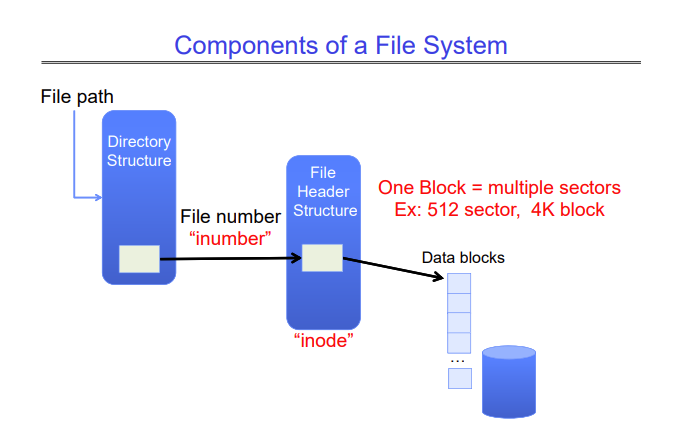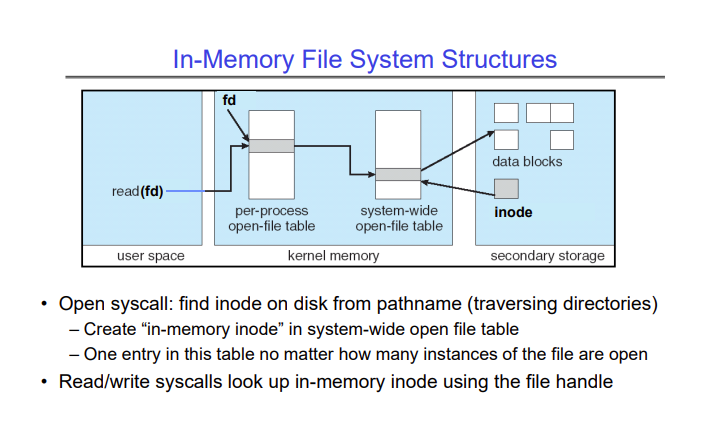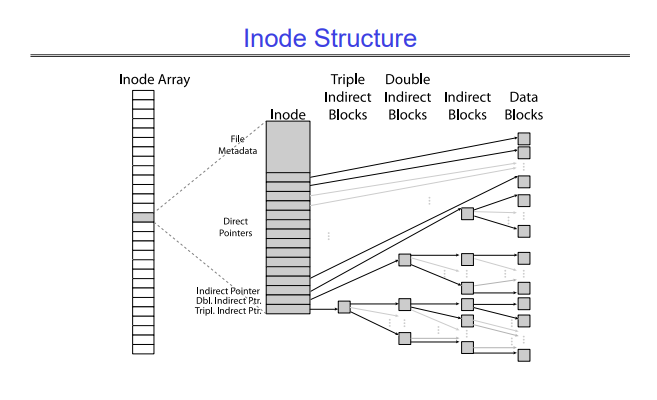Lecture 20 - Filesystems 2: Filesystem Design, Case Studies
The filesystem is responsible for bridging the gap between the API exposed by the operating system to the user (which is byte-oriented), and the API provided by the device driver for the disk to the OS (which is block oriented). The disk only lets you read and write data in blocks which can range from 512 bytes upto 4KB. However, the user is given the illusion that they can access any byte on the disk as they need.
The filesystem provides two entities - files and directories. Files are just a collection of bytes, and a directory is an index that maps a name to a set of files. Each sector of the disk is given an integer address, and the filesystem remembers which files are stored at which addresses.
The filesystem also needs to track additional information such as -
- Free block addresses, in case it has to create new files.
- Which blocks belong to which file, in order to read and write existing files.
- Which directories contain which files.
Since we want all of this data to be persistent after the machine is shut down, we will need to store this data somewhere on the disk. This may become a recursive problem! We can solve this using a small set of fixed addresses for this metadata, or some standard positions for the root of the filesystem.
Components of a File System
A file system has two components - a directory structure map, and a file header structure. The directory structure map is a mapping in a directory that maps a file name to a file number (called an inumber). This inumber is used to find the inode of a file (also called the file header). The inode of a file contains a list of all the blocks that belong to the file.

When a process opens a file, a name resolution is performed in the directory structure to first find the inumber of the file. This inumber is used to look up the inode of the file. This inode describes all the blocks that belong to the file, and now we can read/write these blocks as we want.
A directory in a file system is actually a file that contains a list of mappings of the format <file_name: file_number> for all the files the directory contains. Each of these <file_name: file_number> mapping is called a directory entry, and these are stored in a format that the OS decides. The OS doesn’t let a user process read the raw bytes of a directory (the directory entries), because if these entries are corrupted by an incorrect user process, all the data in the directory could be lost.
When we perform actions on these directories like creating them, moving them, or deleting them, we are actually just modifying this structure. So syscalls like open, create, readdir traverse this structure, and mkdir, rmdir add/remove entries from this structure.
For example, say you wanted to open a file /my/book/count. The OS follows the following steps -
- Read the file header (inode) for the root
/. - Using the inode, read the first data block for the root.
- In this data block, find the directory entry for
my. - If we find it in this block, we proceed, otherwise we read in the next block and look for it there.
- Once we find the directory entry for
my, we read the first block formy. - We look for the directory entry for
book. - We read the first block for
book. - We look for the directory entry for
count. - We get the inode for
count, and now we can read the blocks for/my/book/countas we need.
This is all stored on the disk, however, when we try to open a file, these structures are also created in memory -

Each process has a table that contains the file descriptors of the files the process has opened. When the open syscall is executed, a file descriptor is created for the file and stored in this table. This file descriptor points to an entry in a system-wide open file table, which contains the inode of this file, fetched from the disk and put into RAM.
Case Study: File Allocation Table (FAT)
FAT is a very simple file system. It basically just maintains a table that maps from a file number to a disk block number. Assuming we have a way to turn a file path into a file number, we just look up the file number in the FAT, and it gives us the disk block for the start of that file. If a file spans across multiple blocks, each FAT entry stores a pointer to the FAT entry for the next block of the file.

FAT stores directories in the same way, since directories are just files that store file name to file number mappings. The root directory is stored in FAT entry 2.
The FAT filesystem is simple by design, and is therefore not the most efficient. It is prone to fragmentation, random access is slow, and sequential access can also become slow over time because of fragmentation.
Case Study: Berkley Fast File System
Instead of a file allocation table, the Berkeley Fast File System uses inodes. Inodes first appeared in BSD 4.1 (Berkeley Standard Distribution). An inode is a structure that holds information about a file. Every file has an inumber, which is an index into an array of inodes. The inodes store some metadata about the file, and then they have a few pointers -
- Direct pointers - These pointers point directly to the first few blocks of the file. Each pointer points to one block. There are around 10 to 12 direct pointers, which point to the first 10 to 12 blocks of the file. These pointers are maintained because most files are small, so those small files can be accessed directly.
- Indirect pointers - Indirect pointers point to indirect blocks, which are one level above the data blocks. These indirect blocks mean that you have to follow a tree-like structure to get to the data blocks. This allows the file system to store very large files efficiently.
